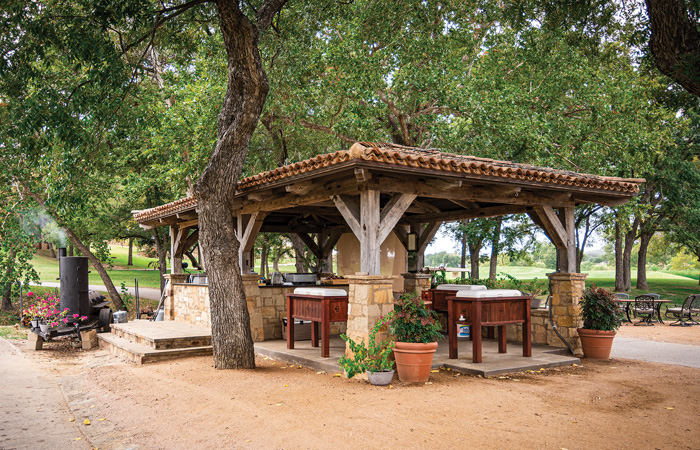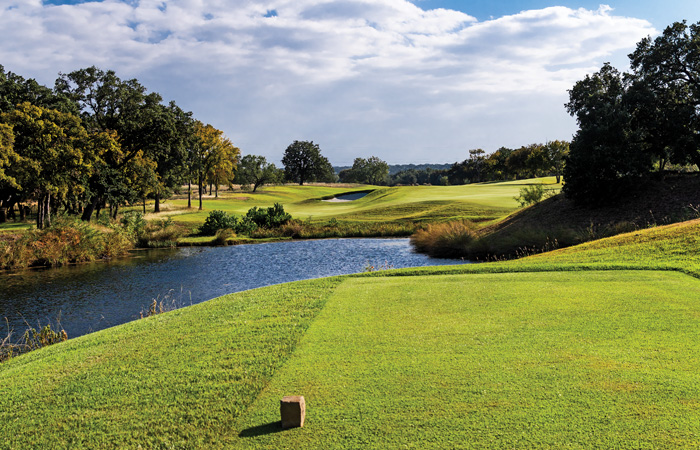The City of Grapevine is known for many things. The Gaylord Texan, the Grapevine Vintage Railroad, Great Wolf Lodge and Grapefest, which is the largest wine festival in the Southwest are all great experiences if you make it to this great suburb.
If you are a golfer, Grapevine should also be on your radar. Of course, there is Cowboys Golf Club, which is a great facility, but it isn’t necessarily the cheapest option in the area. If you are a more budget conscious golfer that is looking for some action in the city of the grape, then might I direct your attention to Grapevine Golf Course. This facility was long a hidden gem in the area, gracing the property immediately next to the levy at Lake Grapevine. Those of us in the know used to always make the trip up to the course for the country club quality course conditions and budget rates.
In the last 15 years, Grapevine is now on just about everyone’s list of the best courses in the area, and that is for good reason. To begin with, Grapevine has three nines, so there are 27 great holes for your tee-to-green enjoyment. The Bluebonnet, the Mockingbird and the Pecan are all worthy and interesting, with plenty of water features, great bunkering, and some interesting terrain changes throughout the three courses.
The courses are fantastic, and to be honest, they could be running things out of a single-wide and I would probably still enjoy the experience, but the addition of a new clubhouse, which officially opened in June, really adds the cherry on top of this muni. Funding for the project was via the city’s bond program, which also approved the construction of a pair of fire stations and a new animal shelter.
The new digs more than doubled the size of the old clubhouse and includes Persimmons Restaurant and bar as well as a grand patio and everything else a player or tournament might need.

“We never really had a way to bring that great experience out there back inside.” Said Director of Golf Russell Pulley. “Now that we have this great clubhouse, I think the players are going to get here early and stick around after they play.”
Persimmons features a bevy of great craft cocktails like the Whiskey Berry Smash, which is a delightful combination of Old Forrester 100 Proof (careful), lemon, honey, and blackberries. There is also a large menu that has appetizers like pork belly burnt ends… yes, you read that right, a Smashburger, brisket tacos, or even a catch of the day fish dinner. So, even if you aren’t teeing it up, this is a great place to have some lunch or dinner.
The restaurant has tons of seating inside, and with the large patio that overlooks the course, it can comfortably dine a little over 200 when at capacity, so this is a course that would easily accommodate your next tournament of business outing. They also have a conference room with doors that can be opened to allow fresh air in when the weather is nice, so if you are looking to impress coworkers with your next big meeting, then this is a great place to do so.
The pro shop is fully stocked with anything you might need for your round, and just outside the golf shop, in the hallway near the entrance to the restaurant, there are plans for a tribute to the late Byron Nelson, who had some input on the course renovation several years back. Nelson’s wife Peggy has generously offered up some memorabilia that will eventually be on display, so keep your eyes peeled for that in the near future.
For a course that saw almost 75,000 rounds in 2020, the conditions are simply amazing. The course maintenance crew should receive medals for the ability to keep a course that sees that much play in such great shape. If you know anything about agronomy, you know that it can be a real bear to keep the course from getting stressed out when it sees that much traffic, not to mention the bonkers weather we can get here in North Texas (see February). I played the course in late August, and it looked more like a course in the middle of spring. No bare spots, no dry spots, no heat damage anywhere. I was stunned.

We started on the Pecan when we visited, and right out of the gate, you are greeted with a challenging, but gettable golf hole. The tee shot is everything here, with players needing to favor the left center of the fairway or risk getting blocked out from the green by trees on the right. A deep bunker guarding the front left of the putting surface can make for a tough up-and-down, but with a good tee shot and a precision iron, there can be a birdie waiting for you.
No. 3 is one of many holes on the Pecan that feature water. The visible water on the left off the tee can swallow shots that are pulled, while a fairway bunker can collect any tee shots that stray as players avoid the dreaded left miss. An aggressive line at the right edge of the water hazard will leave players with a scoring club in-hand and a chance to scribble a three on the card.
The first par-5 of the day comes at No. 4. This is the signature hole of the nine and is known to the locals as the “Dam Hole”, and once you have played it, you know why. The dam is directly to the right and frames the hole nicely. This is one of the most intimidating tee shots on the property, as there is very little room in the fairway. If you should find the short stuff, then you can give the green a go in two, but beware of heading left, as there is a large pecan tree, known as “Byron Nelson’s Tree,” that can get in the way of your third shot if you come up short. It’s a fun, but challenging hole.
For my money, No. 5 on the Pecan is one of the most difficult holes on the property. I play a left to right shot off the tee, so for me, I was forced to take the ball out over the O.B. left and hope for the cut back to the fairway. There is very little landing zone here, especially the farther you hit it off the tee. Should you find the fairway, the green is large and is cut from the front left and runs a good bit back to the right, so if the pin is cut in the back and your shot ends up in the front, there is the potential to have a very long putt remaining. It’s one of the tougher holes out there, in my opinion, and one that will require all your focus.

The toughest hole on the Pecan is No. 6. An aggressive line is at the left corner of the water hazard on the right, but any ball just a touch mishit can end up finding a watery grave and bringing the big number in play. Best to find the left-center of the fairway to be safe, but that leaves a longer approach. It’s a good hole that can really deep-six your round fast if you aren’t precise.
The final hole on the Pecan is the second par-5 of this par-36 layout. This is another hole with water visible and in play off the tee. An aggressive line will leave players with a chance to go for the green in two, but a safer line leaves a layup and a wedge. If you are one of the longer hitters and want to make a run for an eagle, beware of the tree short and right of the green, as it can knock shots down, leaving a tricky third shot. There is definitely an opportunity for a birdie here to round out the nine.
The Mockingbird is another nine of the original design, which opened for play in 1979. This nine compliments its sister nine, the Pecan, well, and has plenty of great holes that can both deliver good scores and challenge even the best players.
The opening hole on the Mockingbird requires a good tee shot, but there is a little bit of room if you maybe haven’t fully warmed up yet and don’t quite hit your best ball. There is a speed slot in the fairway which can springboard balls forward leaving a shorter approach and a chance for a tweeter.
No. 4 is another of my favorites on the Mockingbird. Although it plays just 411-yards, this is another hole where accuracy off the tee is paramount. Miss to the left and there is a creek, or at minimum overhanging trees that can force a punch shot either back into the fairway or one that requires some touch to get it near the putting surface. Miss this green long and it can be a dicey up-and-down as the green slopes from back to front.

The sixth hole is a true risk vs. reward hole. At just over 300 yards, the big hitters can challenge the green off the tee, but if you choose to lay back for position, beware, as there is water everywhere. The fairway slope works left to right, meaning shots that favor the right side could take a detrimental bounce toward the hazard. If you overcorrect and miss too far left, there is water over there too, and players that find either can be looking at bogey or worse. It’s a short hole but it can become a real mess if you aren’t careful off the box.
No. 9 on the Mockingbird is a par-5 that plays 515 from the tips, which means for the long knockers, it can be a real opportunity at a four. Although it plays slightly uphill and there is water down the left, a good tee shot leaves players a chance to get home to this long and skinny green in two, but a smart play might be to lay it up for position and hit a pinpoint wedge.
The newest nine, which opened just before the turn of the century in 1999, is the Bluebonnet nine. Admittedly, this is the nine I have played the fewest times, as I have only been on that side twice, but I can tell you it is every bit as fun and interesting as the Mockingbird and Pecan. D.A. Weibring is responsible for this design, and it opens with a par 5 that can really get your nine off to a great start. At 552 yards, the no-no here is a miss left of the cart path, and that is the case from tee box to green. Stay right, stay out of trouble, and give yourself a chance for a birdie.
No. 3 is a tough nut to crack. Playing a muscular 456 from the black tees, this can be a difficult hole for any skill level player. The blind tee shot is visually intimidating, as any good player will tell you that a tee shot with no eyes on a landing area can be tough to deal with. The second shot will play downhill to an expansive green guarded on the front left with a sand trap.
If you can successfully navigate No. 3, don’t relax too quickly, as the Bluebonnet has another tough customer waiting on the next tee. Overall, I would say the par 3’s across the property are fine, but most of them are pretty straightforward. However, No. 4 on the Weibring design can be difficult to wrangle. There is out-of-bounds left and a forced carry over the native areas makes this 220-yarder a white-knuckle ride. This is a hole where playing the appropriate tees is a must.

As you step to the tee on No. 7, I can assure you the one thing you will be thinking is “grip it and rip it.” This hole plays just 300 yards off the tee and with a well struck tee shot, it can be one that can yield a simple birdie or even an eagle opportunity. Players just need to miss the bunkers on the right and you’re home free.
While there are several holes across the property that showcase some elevation changes, there is no better example that No. 8 on the Bluebonnet. The elevated tee shot on this short par-3 is a great photo opportunity for that Instagram feed and gives players a great chance to stick one close for a two.
The final hole is a last chance to score as you head for the clubhouse. This hole plays 421 from the tips, but a much more manageable 388 from one in. Find the right half of the fairway and it shouldn’t be anything more than a short iron into a green that is receptive to spin, as it slopes from back to front.
As I was playing Grapevine, I continually asked myself why I don’t play there more. Truth be told, it’s not terribly close to my home, but I often play other courses that are a 30 or more-minute drive from the house, and Grapevine is no different. I honestly feel a little stupid that I don’t make the trip to Grapevine more, as the combination of great course conditions, scorable holes, and the addition of their gorgeous new clubhouse makes it an absolute must-play at minimum once a month. It is a property that I intend to add to my regular rotation immediately and hope to play as much as I can in the coming months. Truthfully, and there is no hyperbole here, in my opinion, Grapevine is one of the best overall municipal properties in the Metroplex, if not the entire state. If you appreciate great value and great golf, then you need to play Grapevine, and you need to play it often.